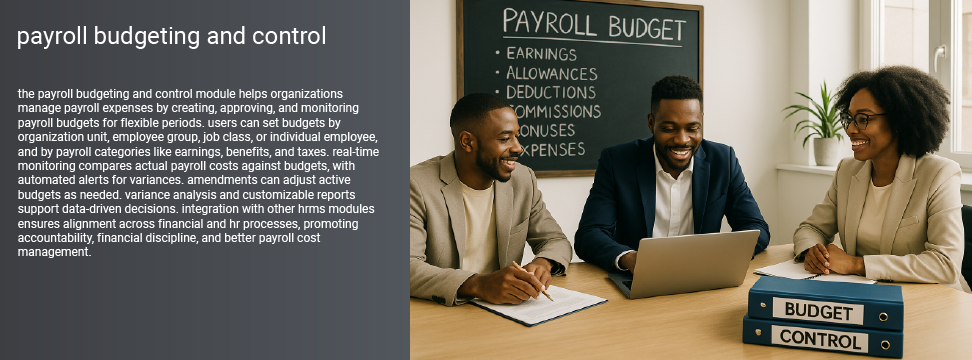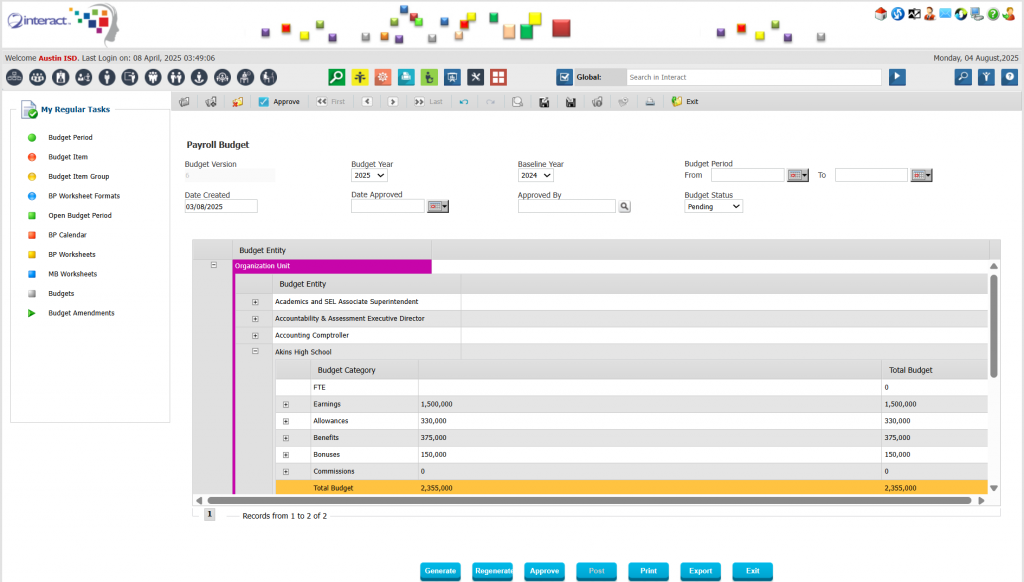Interact HRMS Payroll Budgeting and Control Module Overview
Figure 1: Payroll Budget at Org Unit Level
The Interact HRMS Payroll Budgeting and Control module provides organizations with a powerful tool for managing and controlling payroll expenses. This module allows HR and finance teams to create a payroll budget for specific future periods and monitor payroll spending to ensure that costs remain within budgetary limits. By setting up payroll budgets for defined periods—ranging from as short as two months to as long as a full year—organizations can align payroll expenses with broader financial objectives and prevent overspending.
This module supports the entire payroll budgeting process, from budget creation to approval and monitoring. Once the payroll budget is created and approved, it becomes the active payroll budget for the specified period. During each payroll run, the module compares actual payroll expenses to the budgeted amount, alerting users if the payroll expenses for a particular period exceed the budget. By providing real-time budget control, the Payroll Budgeting and Control module enables organizations to manage payroll expenses proactively, ensuring financial stability and compliance with budgetary guidelines.
Flexible Payroll Budget Period Options, Budget Entities and Budget Categories
Like all other Interact HRMS modules, Payroll Budgeting is highly configurable, and the Payroll Budgeting and Control module includes several setup options, such as the ability to configure the budget periods. Unlike traditional annual budgets, this module allows organizations to create payroll budgets for various timeframes, including multi-month or annual periods, using the regular calendar periods or the fiscal year as its basis. This flexibility enables organizations to tailor their payroll budgeting to match their financial planning cycles, ensuring that payroll costs are managed effectively throughout the year.
The setup allows the user to choose which Budget Entities to include in the Budgets, such as Organization Units, Employee Groups, Job Classes or individual Employees. This means the Payroll Budget can be done at any level of granularity chosen by the organization.
The user can also choose the Budget Categories for which payroll budgeting needs to be done, which will include all the various payroll and compensation elements, including earnings, benefits, allowances, commissions, bonuses, expenses and taxes.
Comprehensive Payroll Budget Creation and Approval Process
The Payroll Budgeting and Control module streamlines the process of creating and approving payroll budgets, providing a structured workflow that ensures accuracy and accountability. The first step in this process is budget creation, where finance and HR teams define projected payroll expenses for the selected budget period. These projections may consider factors such as employee headcount, anticipated salary increases, bonuses, and overtime costs. The goal is to create a payroll budget that reflects the organization’s staffing needs while aligning with its financial goals.
Once the payroll budget is created, it goes through an approval process to ensure that all stakeholders agree on the projected payroll expenses. This approval step is crucial for maintaining financial discipline and avoiding budget discrepancies. After the budget is approved, it is posted as the active payroll budget for the specified period. This structured workflow helps organizations establish a clear and agreed-upon payroll budget, reducing the risk of overspending and promoting transparency within the budgeting process.
Real-Time Payroll Budget Control and Monitoring
With the payroll budget approved and posted, the Payroll Budgeting and Control module enters the active budget control phase. During each payroll run, the system monitors actual payroll expenses for the current pay period and compares them to the budgeted amount for that period. This real-time budget control allows organizations to track payroll spending as it occurs, providing immediate visibility into any potential budget variances.
If the payroll expenses for a specific pay period exceed the budgeted amount, the module generates an alert, notifying users that the payroll costs are above the approved budget. This alert enables HR and finance teams to investigate the cause of the variance and take corrective action if necessary. By providing real-time budget monitoring, the Payroll Budgeting and Control module helps organizations manage payroll expenses proactively, preventing unexpected cost overruns and supporting financial stability.
Amendment of Active Budgets
The module also supports an amendment process to adjust active budgets which have already been approved previously, but which may need amendment either due to an oversight or mistake or otherwise as the result of a budget control process where it was determined that the budget is no longer realistic. In such cases, the user can create a new amended budget which will replace the previous budget.
Automated Alerts and Notifications for Budget Exceedances
The Payroll Budgeting and Control module’s automated alert system is designed to keep users informed about any discrepancies between actual payroll costs and the approved budget. If the payroll expenses for a given pay period exceed the budget, the system triggers an alert to notify the relevant personnel. These alerts allow finance and HR teams to respond promptly to budget overruns, ensuring that payroll spending remains aligned with financial objectives.
These notifications can be customized based on specific budget thresholds, enabling organizations to focus on the most critical budget variances. For example, if an organization sets a threshold of 10% above the budgeted amount, the system will only generate alerts for variances that exceed this threshold. This customization helps prevent alert fatigue and allows finance teams to prioritize their response to significant budget discrepancies.
Enhanced Financial Oversight and Payroll Accountability
The Payroll Budgeting and Control module enhances financial oversight by holding departments accountable for staying within their payroll budgets. By tracking payroll expenses against the approved budget, the module provides a clear record of spending for each pay period. This accountability helps reinforce financial discipline within the organization, ensuring that payroll costs are managed in accordance with the established budget.
The module’s detailed tracking capabilities also support internal audits and financial reporting, providing a transparent record of payroll expenses and budget compliance. This transparency is essential for organizations aiming to maintain high standards of financial accountability, as it enables them to demonstrate adherence to budgetary guidelines and respond to external audits with confidence.
Variance Analysis for Payroll Expenses
To support data-driven decision-making, the Payroll Budgeting and Control module includes variance analysis features that provide insights into the differences between budgeted and actual payroll expenses. This variance analysis helps finance teams understand the factors driving payroll cost fluctuations, whether they are due to unplanned overtime, seasonal staffing increases, or unexpected bonuses.
By analyzing these variances, organizations can identify patterns in payroll spending and make informed adjustments to future budgets. For example, if an organization consistently exceeds its payroll budget during peak production months, it may choose to allocate additional funds to payroll in those periods in future budget cycles. This analysis enables organizations to refine their payroll budgeting process over time, promoting more accurate financial planning and improved budget adherence.
Integration with Other Interact HRMS Modules
The Payroll Budgeting and Control module integrates seamlessly with other Interact HRMS modules, creating a unified financial and HR management system. This integration allows organizations to align payroll budgeting with related processes, such as employee compensation, benefits administration, and position control. By linking payroll budgeting with other HR functions, the module ensures that payroll costs are accounted for in all relevant budgeting and planning activities.
For instance, if a new position is created within the Position Budgeting and Control module, the associated salary and benefits costs are automatically included in the payroll budget, ensuring that the full cost of staffing changes is reflected in financial plans. This integration eliminates the need for manual data entry and reduces the risk of discrepancies between budgeted and actual payroll expenses.
Customizable Payroll Budget Reports
The Payroll Budgeting and Control module offers a variety of configurable reports that provide detailed insights into payroll budgeting and spending. These reports allow finance teams to review payroll expenses against the approved budget, analyze variances, and track spending trends over time. By generating regular payroll budget reports, organizations can monitor their financial health continuously and identify areas for cost-saving opportunities.
These reports can be tailored to meet the specific needs of each organization, enabling finance teams to focus on the metrics that matter most to them. For example, a company may choose to generate monthly payroll budget reports to track expenses in detail, while another organization may prefer quarterly reports for a broader overview of payroll costs.
Summary: Interact HRMS Payroll Budgeting and Control
The Interact HRMS Payroll Budgeting and Control module provides organizations with a structured approach to managing payroll expenses within a defined budget. Key benefits include:
- Flexible Budget Period Options: Create payroll budgets for various timeframes, including months, quarters or annual periods.
- Configurable Budget Entities: The setup allows the user to choose which budget entities to include in the budgets, such as Organization Units, Employee Groups, Job Classes or individual Employees. This means the Payroll Budget can be done at any level of granularity chosen by the organization.
- Confgurable Budget Categories: The user can also choose the budget categories for which payroll budgeting needs to be done, which will include all the various payroll and compensation elements, including earnings, benefits, allowances, commissions, bonuses, expenses and taxes.
- Streamlined Budget Creation and Approval Process: Develop and approve payroll budgets through a structured workflow that ensures accuracy and accountability.
- Real-Time Budget Control and Monitoring: Track payroll expenses against the approved budget in real time, ensuring financial discipline.
- Automated Alerts for Budget Exceedances: Receive alerts if payroll expenses exceed the budgeted amount, allowing for timely corrective action.
- Enhanced Financial Oversight: Promote accountability by monitoring payroll spending within budgetary constraints.
- Variance Analysis for Payroll Expenses: Understand the drivers of payroll cost variances to improve future budgeting.
- Seamless Integration with Other HRMS Modules: Align payroll budgeting with HR functions, including position control and benefits administration.
- Customizable Payroll Budget Reports: Access detailed payroll budget reports to support data-driven decision-making.
By combining these features, the Payroll Budgeting and Control module enables organizations to maintain financial stability, prevent payroll overspending, and make informed adjustments to payroll budgets, ensuring that payroll expenses align with organizational goals.


